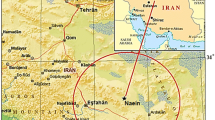Abstract
This paper presents the methodology to develop a synthetically simulated earthquake catalogue for northern Iran. The study area covers the northern boundary of Central Iran Plate, which coincides with the Alborz Mountains. A set of areal seismic sources as well as major active faults and their recurrence relationships is modelled to represent the temporal and spatial distribution of potential earthquakes in this region. Probabilistic sampling of events from various spatial and temporal distribution functions, forming sources of uncertainties, is used to generate synthetic events. Areal seismic sources oriented more towards representation of general and background seismicity, derived from statistical and spatial analyses on historical earthquakes. Recurrence relationships as well as potential maximum magnitudes for seismic sources are estimated from records of historical earthquakes and where available from measured and calculated slip rates from recent GPS surveys in this region. The synthetically generated earthquake catalogue provides a realization of potential earthquakes, each characterized with a defined magnitude, location, focal depth, faulting orientation and recurrence frequency. The catalogue is used for assessment of probabilistic seismic hazard, and the results are presented for a test point in the city of Tehran.














Similar content being viewed by others
References
Alavi M (1996) Tectonostratigraphic synthesis and structural style of the Alborz mountain system in northern Iran. Geodynamics 21(1):1–33
Allen MB, Ghassemi MR, Sharabi M, Qorashi M (2003) Accommodation of late Cenozoic oblique shortening in the Alborz range, Iran. J Struct Geol 25:659–672
Ambraseys NN, Melville CP (1982) A history of Persian earthquakes. Cambridge University Press, Cambridge 219
Ambraseys NN, Melville CP (1996) The catalogue of Persian Earthquakes. Internal report. Imperial College of Science and Technology, University of London, UK
Berberian M (1983) The southern Caspian: a comparison depression floored by a trapped, modified oceanic crust. Can J Earth Sci 20:163–183
Berberian M, Yeats RS (2001) Contribution of archeological data to studies of earthquake history in the Iranian Plateau. J Struct Geol 23:563–584
Campbell KW, Bozorgnia Y (2008) NGA ground motion model for the geometric mean horizontal component of PGA, PGV, PGD and 5% damped linear elastic response spectra for periods ranging from 0.01 to 10s. Earthq Spectra 24(1):139–171
Cornell CA (1968) Engineering seismic risk analysis. Bull Seismol Soc Am 58:1583–1606
Engdahl ER, Jackson JA, Myers SC, Bergman EA, Priestley K (2006) Relocation and assessment of seismicity in the Iran region. Geophys J Int 167:761–778
Gardner JK, Knopo L (1974) Is the sequence of earthquakes in Southern California, with aftershocks removed, Poissonian? Bull Seismol Soc Am 64(5):1363–1367
Ghodrati Amiri G, Razavian Ameri SA, Motamed R, Ganjavi B (2007) Uniform hazard spectra for different northern part of Tehran, Iran. J Appl Sci 22:3368–3380
Jackson JA, Priestley K, Allen M, Berberian M (2002) Active tectonics of the South Caspian Basin. Geophys J Int 148:214–245
Mc Guire RK (1995) Probabilistic seismic hazard analysis and design earthquake: closing the loop. Bull Seismol Soc Am 85:1275–1284
Nowroozi AA (2010) Probability of peak ground horizontal and peak ground vertical accelerations at Tehran and surrounding areas. Pure appl Geophys 167:1459–1474
Ritz JF, Nazari H, Salamati HAR, Shafeii A, Solaymani S (2006) Active transtension inside Central Alborz: a new insight into the Northern Iran-Southern Caspian geodynamics. Geology 34:477–480
Schwartz DP, Coppersmith KJ (1984) Fault behaviour and characteristic earthquakes: examples from the Wasatch and San Andreas Fault Zones. J Geophys Res 89:5681–5698
Stepp JC (1972) Analysis of completeness of the earthquake sample in the Puget Sound area and its effects on statistical estimate of earthquake hazard. In: Proceedings First Microzonation Conference, Seattle, USA, pp 897–909
Tchalenko JS (1975) Seismicity and structure of Kopet Dagh (Iran). Phil Trans Roy Soc Lond 278:1–25
Vernant P, Nilforoushan F, Bayer R, Chéry J, Djamour Y, Masson F, Nankali H, Ritza J-F, Sedighi M, Tavakoli F (2004) Deciphering oblique shortening of central Alborz in Iran using geodetic data. Earth Planet Sci Lett 223:177–185
Yaghmaei-Sabegh S, Lam NTK (2010) Ground motion modeling in Tehran based on the stochastic method. Soil Dyn Earthq Eng 30:525–535
Yazdani A, Shahpari A, Salimi MR (2012) The use of Monte-Carlo simulations in seismic hazard analysis in Tehran and surrounding areas. Int J Eng 25:159–165
Zafarani H, Noorzad A, Ansari A, Barghi K (2009) Stochastic modeling of Iranian earthquakes and estimation of ground motion for future earthquake in Greater Tehran. Soil Dyn Earthq Eng 29:722–741
Zolfaghari MR (1998) GIS-based seismic hazard assessment for Iran. Ph.D. dissertation, Department of Civil Engineering, Imperial College, London, 249 pp
Zolfaghari MR (2009) Use of raster-based date layers to model spatial variation of seismotectonic data in probabilistic seismic hazard assessment. J Comput Geosci 35:1460–1469
Author information
Authors and Affiliations
Corresponding author
Rights and permissions
About this article
Cite this article
Zolfaghari, M.R. Development of a synthetically generated earthquake catalogue towards assessment of probabilistic seismic hazard for Tehran. Nat Hazards 76, 497–514 (2015). https://doi.org/10.1007/s11069-014-1500-1
Received:
Accepted:
Published:
Issue Date:
DOI: https://doi.org/10.1007/s11069-014-1500-1



